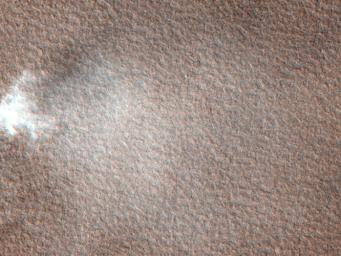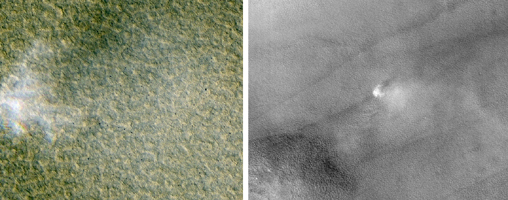
|
Record-Breaking Dust Devil Caught in the Act
- Click the image above for a larger view
- Full-Res JPEG (2560 x 1920) (1.3 MB)
- Full-Res TIFF (2560 x 1920) (14.8 MB)
Caption:

Click on the image for larger version
Original release date March 17, 2010.
Sometimes HiRISE finds something unexpected.
This image was targeted to study knobs in Mars' northern plains, just north of Scandia Crater. The knobs are clearly imaged, but what surprised scientists was a dust devil visible in the south-central part of the image (see inset above).
As on Earth, dust devils form when ground heated by sunlight warms the air above it. The hot air rises, forming an updraft accompanied by vortical motions. Because warm ground is a requirement, dust devils on Mars generally form in late spring to summer, especially at high latitudes.
This image was taken in early spring (2010), at a latitude of 61 degrees North. No dust devil has been seen this far from the equator at such an early season before.
Background Info:
The University of Arizona, Tucson, operates the HiRISE camera, which was built by Ball Aerospace & Technologies Corp., Boulder, Colo. NASA's Jet Propulsion Laboratory, a division of the California Institute of Technology, Pasadena, manages the Mars Reconnaissance Orbiter for the NASA Science Mission Directorate, Washington. Lockheed Martin Space Systems, Denver, is the spacecraft development and integration contractor for the project and built the spacecraft.
Cataloging Keywords:
| Name | Value | Additional Values |
|---|---|---|
| Target | Mars | |
| System | ||
| Target Type | Planet | |
| Mission | Mars Reconnaissance Orbiter (MRO) | |
| Instrument Host | Mars Reconnaissance Orbiter | |
| Host Type | Orbiter | |
| Instrument | High Resolution Imaging Science Experiment (HiRISE) | |
| Detector | ||
| Extra Keywords | Color, Crater, Dust | |
| Acquisition Date | ||
| Release Date | 2010-03-22 | |
| Date in Caption | 2010-03-17 | |
| Image Credit | NASA/JPL-Caltech/University of Arizona | |
| Source | photojournal.jpl.nasa.gov/catalog/PIA12876 | |
| Identifier | PIA12876 | |
